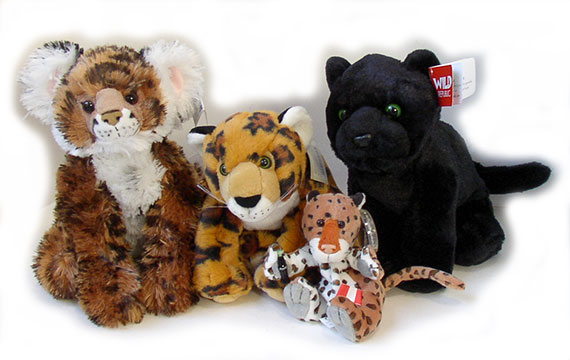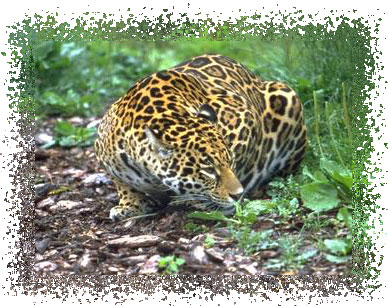

Jaguar Big Cat Plush Toys
Discover Mexico's el tigre, the Jaguar, at Animals N More. Also find beautiful Jaguar plush toys at our sponsor's online gift shop.
The Jaguar, Panthera (Jaguarius) onca, is the New World's biggest cat. A sturdy, powerful creature, it may be six or eight feet long, over-all, and weigh up to 250 pounds. No wonder the people of Mexico and Central America call the jaguar el tigre, and make a hasty retreat when they glimpse its tawny, black-spotted form in some dense jungle thicket. Among the cats, only the lion and tiger are larger than the jaguar.
Although this great, dangerous beast has disappeared from many of the places it once haunted, it is still found from Patagonia all the way through South and Central America, and as far north as Texas, New Mexico, and Arizona in the United States. Commonest in the tropical lowlands, where it often dwells in the marshes, it will make its home in arid and mountainous regions as well.
At night, the jaguar's deep, throaty roar wakes the jungle and fills its inhabitants with terror. No living creature is secure from the big cat's savage assault. Along the rivers it will tackle the alligator or the huge capybara, giant of the rodent race. It will pounce upon the turtle, turn it over, and rip it out of its shell. A strong swimmer, the jaguar often will not abandon the intended victim that seeks safety in the water. Even the monkeys in the trees sense imminent danger when they hear the lithe cat snarl, for they know it can climb and leap from branch to branch with impressive agility. The peccaries, wild pigs of the jungle, are a special favorite of the jaguar's and domestic stock, too, frequently falls prey to it.
Every now and then the jaguar decides it would like a fish dinner. So it looks for a low branch that reaches out over a stream, or a rock that offers equally convenient access to the water. Fisherman might well envy the jaguar its easy angling technique. Resting on the comfortable perch it has selected, the cat extends it paw into the water and scoops up the fish.
There is, however, sufficient evidence to prove that the jaguar does on occasion attack man. It is the only American animal that becomes a man-eater by habit. Not every jaguar will kill people -- only certain individuals are guilty. Instances of such attacks are becoming less common; the cats seem to be learning to avoid the man with the gun.
The jaguar is a handsome cat, with a coat that is rich yellow or tawny in color, marked with a chain of black spots down the back, bordered by five rows of black rosettes, running lengthwise on the sides. Its tail, limbs, and head are heavily spotted and lined with black. The larger head, stocky and more robust form, shorter tail, and larger rosettes serve to distinguish it from the leopard. At least a dozen subspecies are known. Black jaguars are not unusual, especially in the valley of the Amazon. There are spots present even on these, but only a good light will reveal them.
The jaguar may mate at any time of the year. About one hundred days later, two to four kittens are born. They are more heavily spotted than the adults, but lack rosettes. The male appears to be a permanent member of the family; he is a good provider and he is ready to feed and protect his young at all times. But when the kittens are a year old, they are capable of taking care of themselves, and when they reach three years they are old enough to breed. The jaguar's life span is about twenty years.




